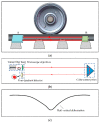Recent Advances in Wayside Railway Wheel Flat Detection Techniques: A Review
- PMID: 37112257
- PMCID: PMC10144077
- DOI: 10.3390/s23083916
Recent Advances in Wayside Railway Wheel Flat Detection Techniques: A Review
Abstract
Wheel flats are amongst the most common local surface defect in railway wheels, which can result in repetitive high wheel-rail contact forces and thus lead to rapid deterioration and possible failure of wheels and rails if not detected at an early stage. The timely and accurate detection of wheel flats is of great significance to ensure the safety of train operation and reduce maintenance costs. In recent years, with the increase of train speed and load capacity, wheel flat detection is facing greater challenges. This paper focuses on the review of wheel flat detection techniques and flat signal processing methods based on wayside deployment in recent years. Commonly used wheel flat detection methods, including sound-based methods, image-based methods, and stress-based methods are introduced and summarized. The advantages and disadvantages of these methods are discussed and concluded. In addition, the flat signal processing methods corresponding to different wheel flat detection techniques are also summarized and discussed. According to the review, we believe that the development direction of the wheel flat detection system is gradually moving towards device simplification, multi-sensor fusion, high algorithm accuracy, and operational intelligence. With continuous development of machine learning algorithms and constant perfection of railway databases, wheel flat detection based on machine learning algorithms will be the development trend in the future.
Keywords: signal processing method; wayside signal acquisition method; wheel flat detection.
Conflict of interest statement
The authors declare no conflict of interest.
Figures











Similar articles
-
In-Service Detection and Quantification of Railway Wheel Flat by the Reflective Optical Position Sensor.Sensors (Basel). 2020 Sep 2;20(17):4969. doi: 10.3390/s20174969. Sensors (Basel). 2020. PMID: 32887346 Free PMC article.
-
An Unsupervised Learning Approach for Wayside Train Wheel Flat Detection.Sensors (Basel). 2023 Feb 8;23(4):1910. doi: 10.3390/s23041910. Sensors (Basel). 2023. PMID: 36850515 Free PMC article.
-
Wheel Out-of-Roundness Detection Using an Envelope Spectrum Analysis.Sensors (Basel). 2023 Feb 14;23(4):2138. doi: 10.3390/s23042138. Sensors (Basel). 2023. PMID: 36850739 Free PMC article.
-
A Survey on Multi-Sensor Fusion Perimeter Intrusion Detection in High-Speed Railways.Sensors (Basel). 2024 Aug 23;24(17):5463. doi: 10.3390/s24175463. Sensors (Basel). 2024. PMID: 39275374 Free PMC article. Review.
-
A Review of NDT Methods for Wheel Burn Detection on Rails.Sensors (Basel). 2023 May 31;23(11):5240. doi: 10.3390/s23115240. Sensors (Basel). 2023. PMID: 37299966 Free PMC article. Review.
Cited by
-
RSDNet: A New Multiscale Rail Surface Defect Detection Model.Sensors (Basel). 2024 Jun 1;24(11):3579. doi: 10.3390/s24113579. Sensors (Basel). 2024. PMID: 38894369 Free PMC article.
-
FaultSeg: A Dataset for Train Wheel Defect Detection.Sci Data. 2025 Feb 20;12(1):309. doi: 10.1038/s41597-025-04557-0. Sci Data. 2025. PMID: 39979297 Free PMC article.
References
-
- Cilt China. [(accessed on 13 January 2023)]. Available online: http://www.ciltchina.cn/index.php?case=archive&act=show&aid=304.
-
- FRA Office of Safety Analysis. [(accessed on 13 January 2023)]; Available online: https://safetydata.fra.dot.gov/OfficeofSafety/publicsite/summary.aspx.
-
- Ye Y.G., Shi D.C., Poveda-Reyes S., Hecht M. Quantification of the influence of rolling stock failures on track deterioration. J. Zhejiang Univ. Sci. A. 2020;21:938. doi: 10.1631/jzus.A20e0033. - DOI
-
- Chong S.Y., Lee J.R., Shin H.J. A review of health and operation monitoring technologies for trains. Smart Struct. Syst. 2010;6:1079–1105. doi: 10.12989/sss.2010.6.9.1079. - DOI
-
- Alexandrou G., Kouroussis G., Verlinden O. A comprehensive prediction model for vehicle/track/soil dynamic response due to wheel flats. Proc. Inst. Mech. Eng. F J. Rail Rapid Transit. 2016;230:1088–1104. doi: 10.1177/0954409715576015. - DOI
Publication types
Grants and funding
LinkOut - more resources
Full Text Sources

